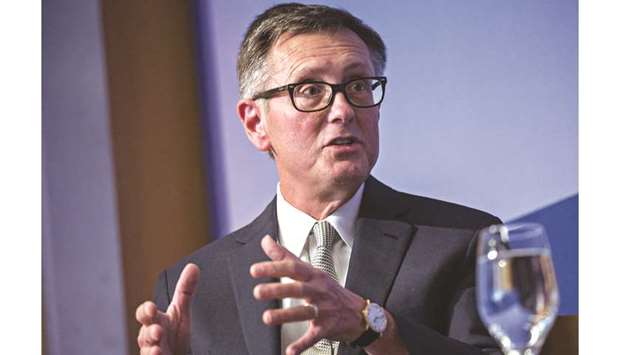Federal Reserve officials have said little to take a third straight interest-rate cut off the table when they meet this month. They also haven’t said much about what they’ll do after that.
Fed vice chairman Richard Clarida, in remarks on Friday on the final day before the central bank goes into a blackout period before its October 29-30 meeting, saw lots to be happy about in the domestic economy. But there’s also risks that weakness from abroad, which has already hit manufacturing, will seep into the wider US economy.
“Global growth estimates continue to be marked down, and global disinflationary pressures cloud the outlook for US inflation,” Clarida said in Boston. Trade disputes have slammed global manufacturing and US growth is expected to slow in the second half of the year.
Traders have almost entirely priced in a quarter percentage point cut at the upcoming Fed meeting, which would match its moves in July and September.
“It’s something of a bimodal outlook,” Brian Sack, director of global economics at D E Shaw group, told an Institute of International Finance conference October 17 in Washington. “We either stabilise with one more cut, or I think we’re going to go all the way to the lower bound.”
The last time the Fed reduced rates three times while the economy was growing was in 1998. After the third cut, it sent a strong signal it was done, announcing that financial conditions following 75 basis points of easing “can reasonably be expected” to sustain the expansion.
Don’t expect a repeat of that guidance if they do move this month.
Officials probably see enough risks that they will want to maintain the flexibility to cut rates further. But keeping the door wide open could create expectations that the current path is something more like a protracted cycle than a mid-cycle adjustment, as Chairman Jerome Powell has called it.
Several officials in September, according to meeting minutes, were eager to push back against that perception. “I felt very strongly at this stage in July and September that we should be taking action,” Dallas Fed chief Robert Kaplan said on Friday in Washington.
“I’m more agnostic as we sit here today as to whether we should take, or I should take, more time, understanding we have the December meeting also.”
Matthew Luzzetti, chief US economist at Deutsche Bank Securities, said the picture is being complicated by the fact that risks to the outlook have flipped. Private sector job growth is decelerating and retail sales fell last month. But external risks, such as Brexit and the trade dispute with China, appear to be moderating.
“Now we’re in an environment where the incoming data has actually softened but perhaps we’re moving to world where the risks may not be as severe,” Luzzetti said. Still, “with the whole trade policy remaining murky and the data softening it would be hard for them at this point to send a signal that we are done at least for the foreseeable future.”
The burden of saying what comes next will fall to Powell at his Oct. 30 press conference following the Fed’s meeting. It has been careful to omit forward guidance in recent policy statements, saying that it will “monitor the implications of incoming information” and “act as appropriate.”
Powell will probably push back on talk of recession by noting the economy is in a “good place” – a refrain he and other officials have repeated multiple times this year. But he is unlikely to say much about future action, which carries its own communication challenge.
“They don’t want markets to presume there will be a rate cut in December,” said Derek Tang, an economist at LH Meyer Inc, a policy research firm in Washington. “The danger is boxing themselves into a corner where there is always the expectation of ‘one more cut.’ Beyond three, it sounds like you are going all the way to zero.

Richard Clarida, vice-chairman of the US Federal Reserve, speaks during a discussion at the Peterson Institute for International Economics in Washington, DC. (file). Clarida, in remarks on Friday on the final day before the central bank goes into a blackout period before its October 29-30 meeting, saw lots to be happy about in the domestic economy.


